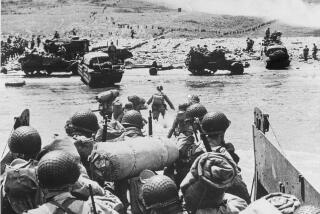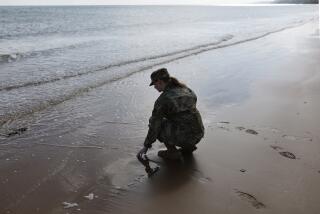D-Day Fresh in a Photographic Memory
- Share via
SAINTE MARIE DU MONT, France — Martin Lederhandler, still an active Associated Press photographer after a record 58 years, landed on D-day with the 165th Signal Photo Company, attached to the 4th Infantry Division. He returned to photograph the site 50 years later and filed this report:
On D-day, I sent my film of the landing to England by carrier pigeon. But the pigeon got tired and was captured in Le Havre, so one of my pictures appeared on Page 1 of a German newspaper. They even gave me a byline.
When I returned to Normandy after 50 years for a friendly invasion, my memories seemed to fade in the mist and fog of wind-swept Utah Beach. Strolling along, I tried to recapture the D-day events.
A Belgian family’s 2-year-old was playing in the sand. A hearty chef from nearby Carentan was flying a kite in the rough weather, using two hand controls.
Farther on was the first evidence that all of it truly had happened on that long-ago 6th of June: In the low tide, I spotted the rusted remains of an LCI (Landing Craft Infantry) left as a monument. On the dunes above the beach were a Sherman tank and a rusting German anti-aircraft gun.
Memories flooded back.
I was part of a unit of the 165th Signal Photo Co. attached to the 4th Infantry Division. My job was to record the division’s activities on D-day and send my film back across the English Channel with pigeons that had been given to me in Portsmouth.
The pigeons, I was told, had been raced from Calais to Dover in peacetime and were familiar with the crossing. What I was not told was that pigeons will not fly--at least not very far--after three days in a canvas case without exercise.
I sent my two birds off after shooting only 10 frames on a short roll of film, and lightened my load by heaving their canvas traveling case overboard. I had more than enough other gear, what with chemical-dipped underwear in case the Germans used gas, a life preserver belt, pistol, gas mask, camera equipment and personal effects.
Three weeks later, I learned that one of the pigeons had landed in Le Havre, exhausted, and was captured by the enemy.
In a German bunker in Cherbourg, I found a German newspaper with one of my pictures of our LST (Landing Ship Tank) number 282 on the front page. The caption gave me a byline, since I had sent my unit identification along with the film. It also said we were later destroyed by artillery fire. Not true.
Our Signal Corps units had been given six or eight pigeons to carry our film. Mine was the only one ever found, and the wrong people found it. Did anybody kid me about it? Guess.
On my return visit to Normandy, I toured the American Cemetery at Colleville-Sur-Mer near Omaha Beach, where 9,386 U.S. soldiers are buried, 350 of them unidentified. The names of 1,557 Americans missing in action are listed on a wall.
In La Cambe, a nearby town, I went to a cemetery where 21,160 German soldiers are buried.
Fifty years ago, the sea and sky were filled with 1,000 ships and 1,000 planes carrying 250,000 soldiers to free a continent.
Many thousands of men died, on both sides. A plaque at the entrance to the American Cemetery admonishes, fittingly: “Silence and Respect.”
RELATED STORIES: A29
More to Read
Sign up for Essential California
The most important California stories and recommendations in your inbox every morning.
You may occasionally receive promotional content from the Los Angeles Times.













